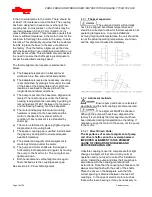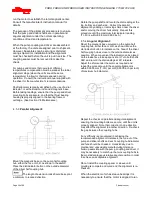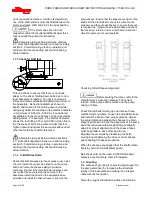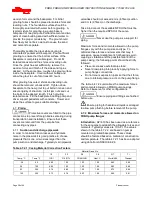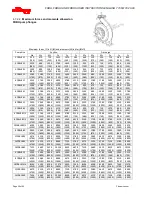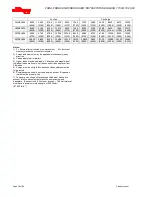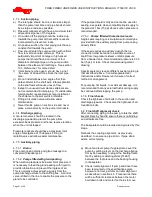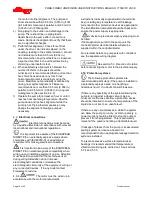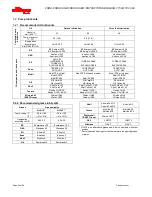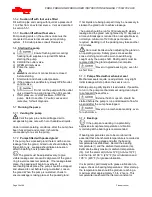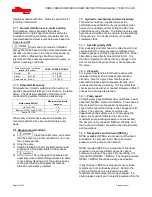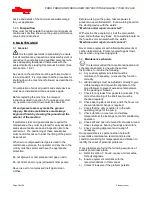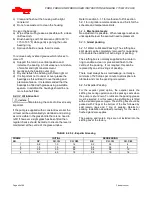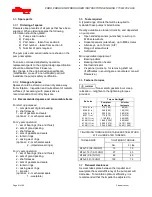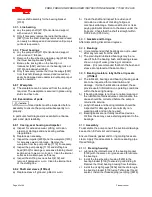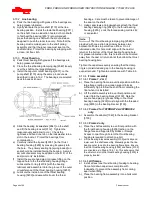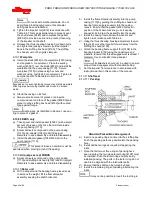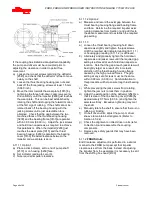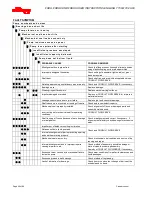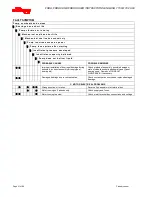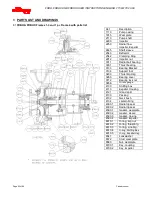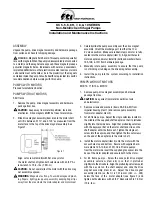
FRBH, FRBHX AND FRBHS USER INSTRUCTIONS ENGLISH 71569178 20-08
Page 39 of 60
Flowserve.com
®
6.2.1
Routine inspection (daily/weekly)
The following checks should be made
and the appropriate action taken to remedy any
deviations:
a)
Check operating behaviour. Ensure noise,
vibration and bearing temperatures are normal.
b)
Check that there are no abnormal fluid or lubricant
leaks (static and dynamic seals) and that any
sealant systems (if fitted) are full and operating
normally.
c)
Check that shaft seal leaks are within acceptable
limits.
d)
Check the level and condition of oil lubricant. On
grease lubricated pumps, check running hours
since last recharge of grease or complete grease
change.
e)
Check any auxiliary supplies eg heating/cooling (if
fitted) are functioning correctly.
Refer to the manuals of any associated
equipment for routine checks needed.
6.2.2
Periodic inspection (six monthly)
a)
Check foundation bolts for security
of attachment and corrosion.
b) Check pump running records for hourly usage to
determine if bearing lubricant requires changing.
c)
The coupling should be checked for correct
alignment and worn driving elements.
Refer to the manuals of any associated
equipment for periodic checks needed.
6.2 3
Re-lubrication
Lubricant and bearing temperature analysis can be
useful in optimizing lubricant change intervals. In
general however, the following is recommended.
6.2.3.1 Grease lubrication
See section 5.2.2 for grease
recommendations.
Re-greasing quantities for each bearing are contained in
the table below. Please note that standard pumps are oil
lubricated. Grease only when factory installed grease
fittings are supplied.
Table 6.2.3.1 Bearing Regreasing Quantities
BRG.
THRUST BEARING
LINE BEARING
FRAME SIZE
OZ.
CU. IN.
CU. CM.
OZ.
CU. IN.
CU. CM.
1
1
1.2
20
2
2.4
40
2
3
3.6
60
4
4.9
80
3
7
8.5
140
5
6.1
100
4
9
11.0
180
6
7.3
120
Regrease
- via grease nipples every 2 000 hours or
sooner depending on the severity of the application.
It is important not to under or over grease the bearings
as this will lead to over heating and premature failure.
a) Grease lubricated bearing housings have grease
nipples fitted in the bearing covers.
b) Move the axial seal ring back so the gap between
the pump shaft and bearing cover can be seen.
c) Connect grease gun to the nipple.
d) Press grease into the bearing housing until the
first signs of it appear in the gap between the
housing and shaft, then stop greasing.
e) V-rings should be seated at the proper distance
from the sealing surface to avoid overheating.
f) The maximum allowable operating temperatures
for anti friction bearings will vary from unit to unit,
depending on ambient and fluid temperature. The
rise above ambient should not normally exceed
55
C (131
F) or a combined maximum of 95
C
(204
F).
g) A continuously rising temperature or an abrupt
temperature rise indicates a problem. If these
symptoms occur, stop the pump immediately and
investigate the cause.
TIME
TEMP
ERA
TU
RE
Grease change
- every 4 000 hours or sooner
depending on the severity of the application.
a) Remove the bearing housing from the rotor
assembly.
b) Brush the bearing housing with hot kerosene (100
to 115 °C/212 to 240 °F) or other non-toxic
solvent.

